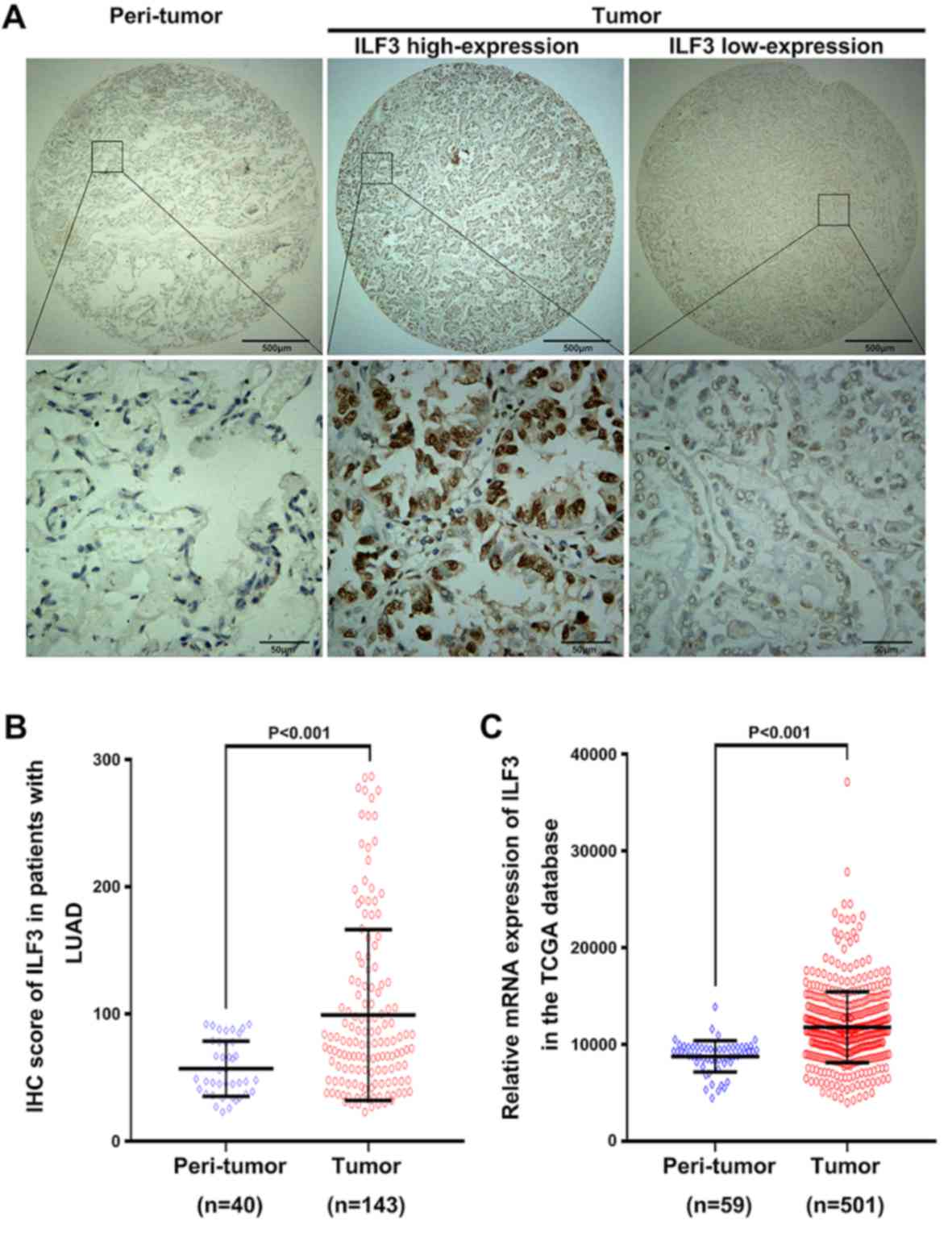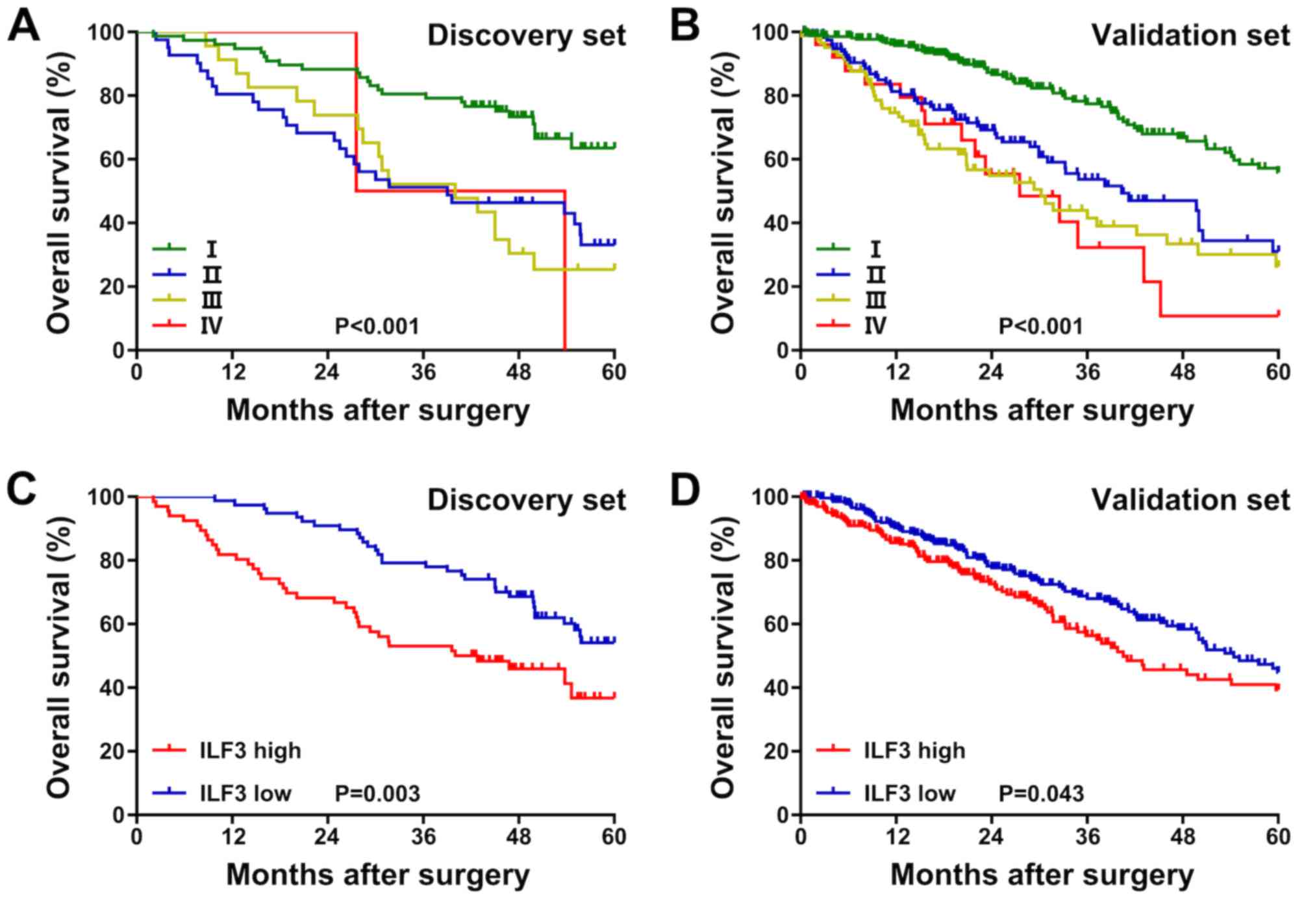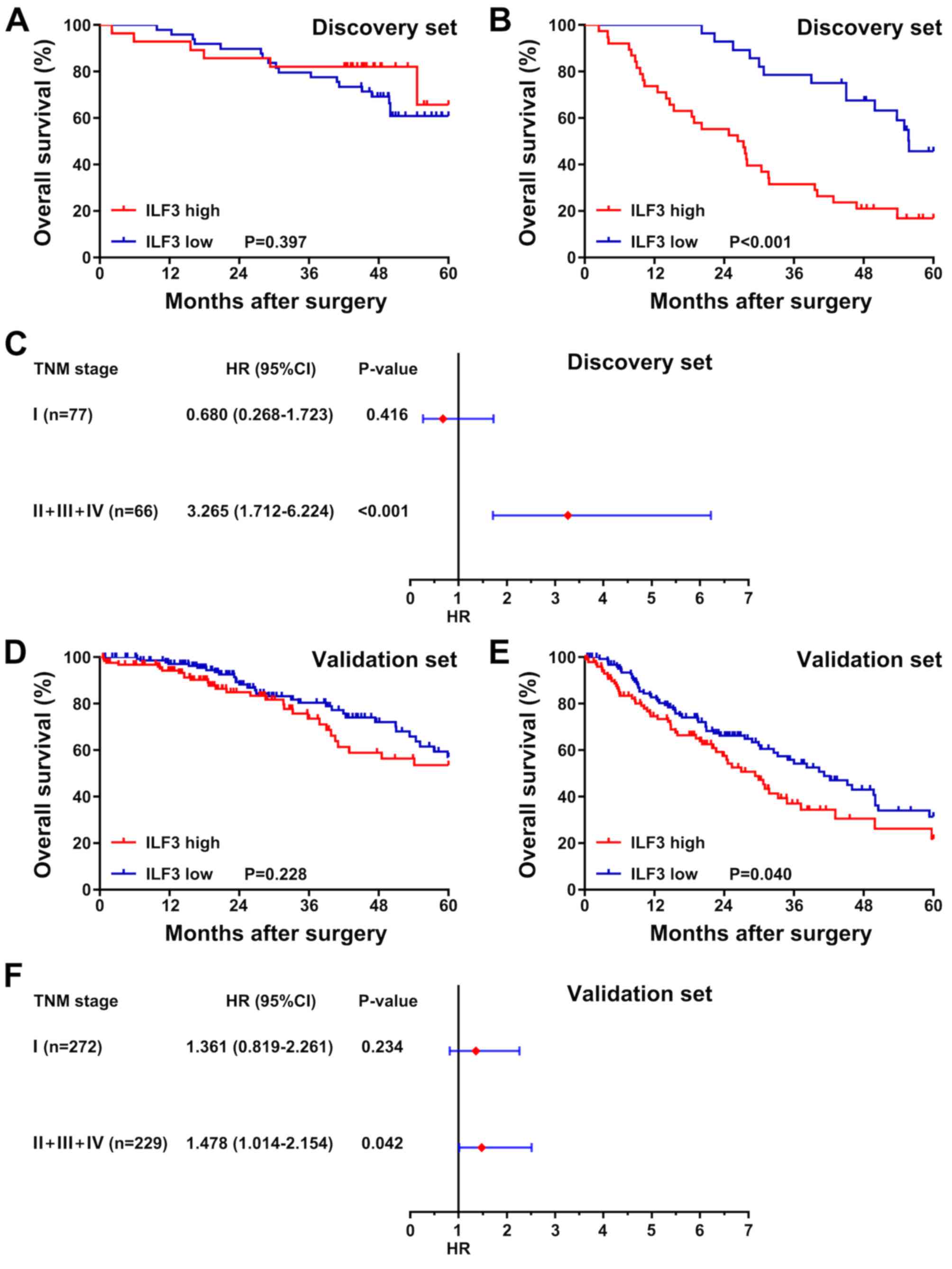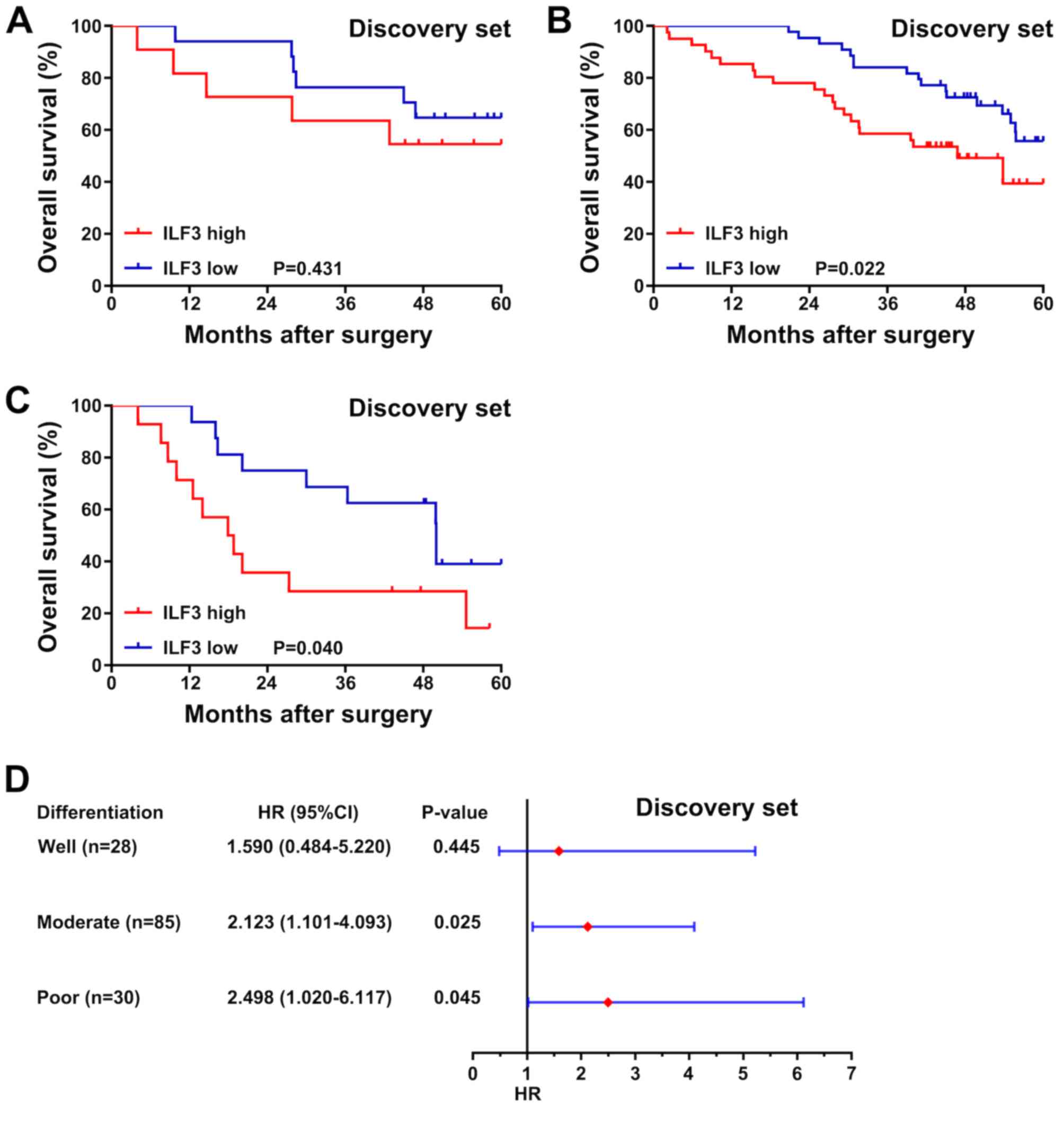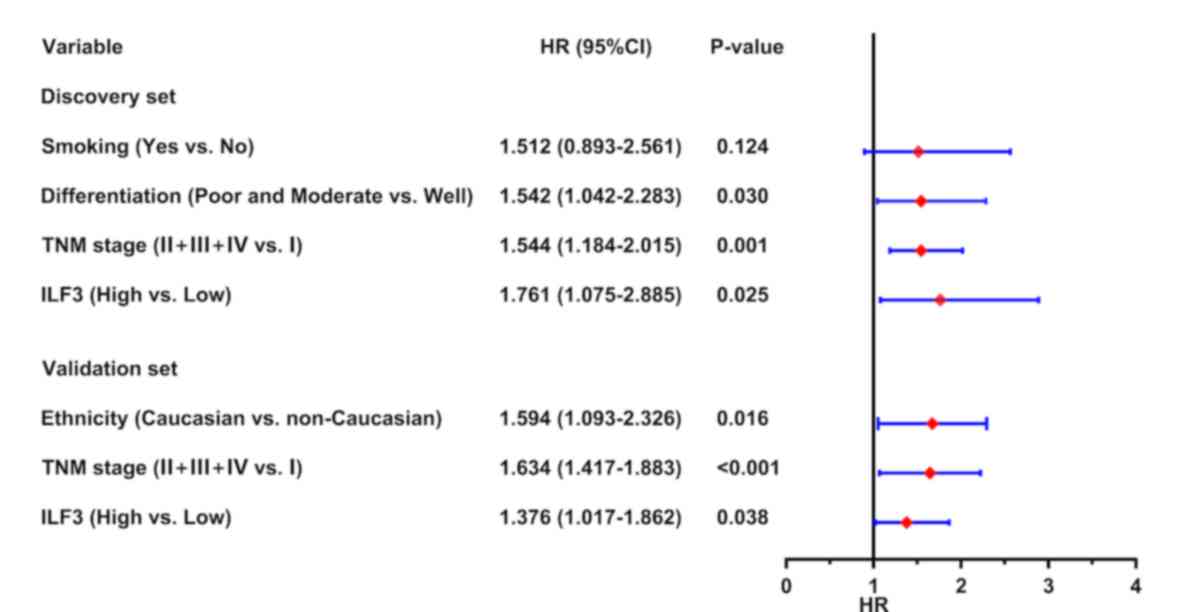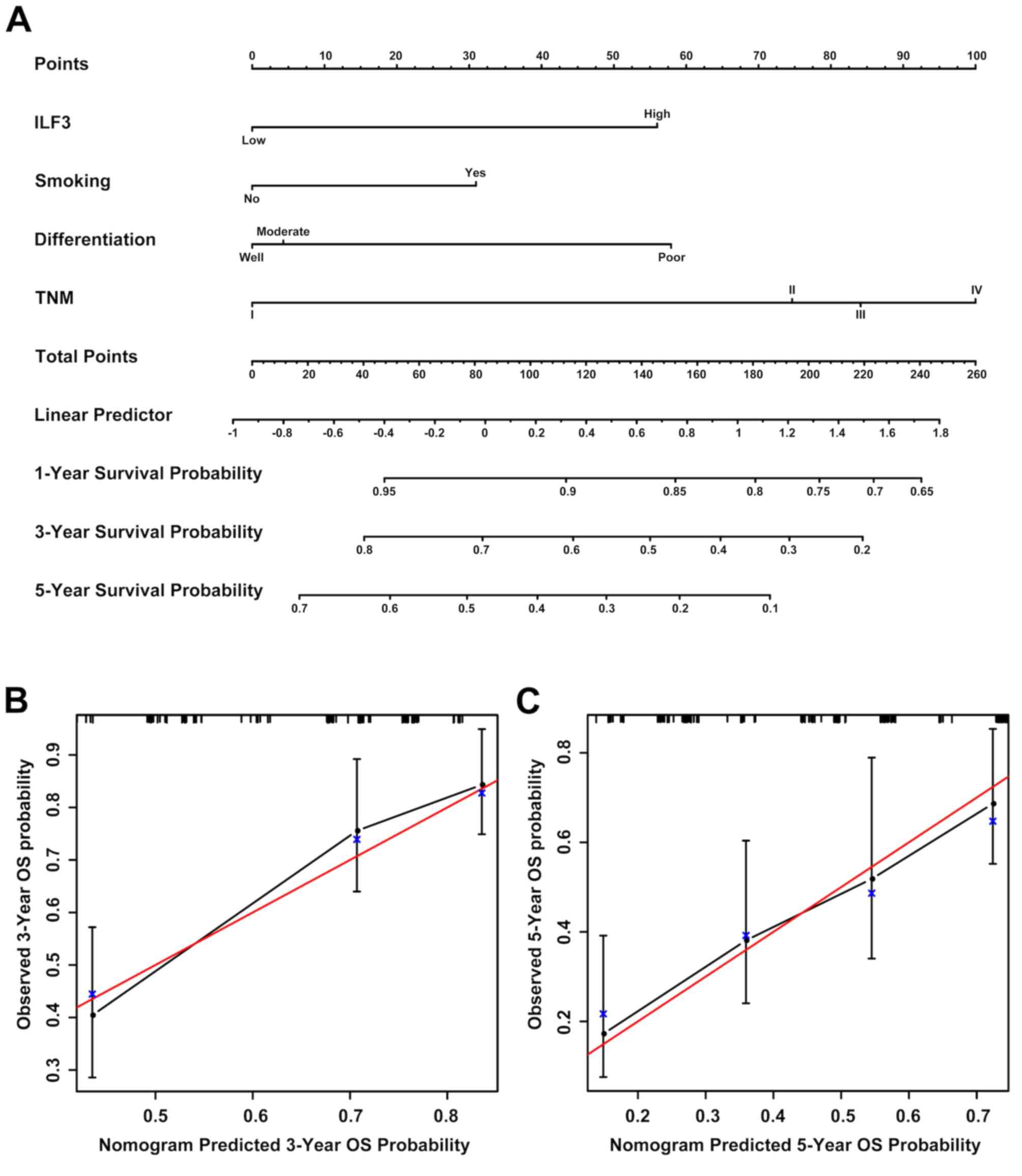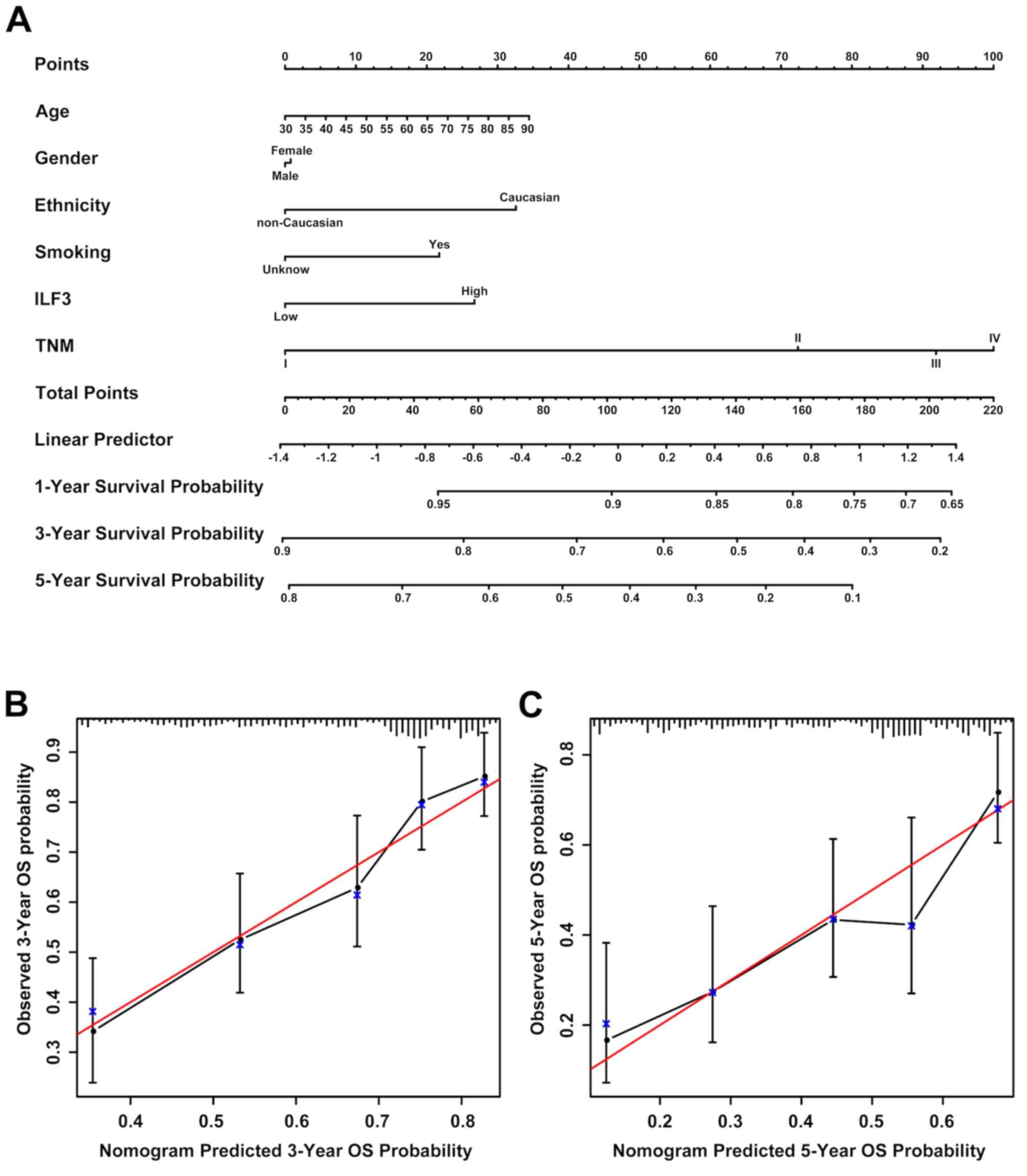|
1
|
Ferlay J, Shin HR, Bray F, Forman D,
Mathers C and Parkin DM: Estimates of worldwide burden of cancer in
2008: GLOBOCAN 2008. Int J Cancer. 127:2893–2917. 2010. View Article : Google Scholar : PubMed/NCBI
|
|
2
|
Chen W, Zheng R, Baade PD, Zhang S, Zeng
H, Bray F, Jemal A, Yu XQ and He J: Cancer statistics in China,
2015. CA Cancer J Clin. 66:115–132. 2016. View Article : Google Scholar : PubMed/NCBI
|
|
3
|
Molina JR, Yang P, Cassivi SD, Schild SE
and Adjei AA: Non-Small cell lung cancer: Epidemiology, risk
factors, treatment, and survivorship. Mayo Clin Proc. 83:584–594.
2008. View
Article : Google Scholar : PubMed/NCBI
|
|
4
|
Yao S, Zhong L, Liu J, Feng J, Bian T,
Zhang Q, Chen J, Lv X, Chen J and Liu Y: Prognostic value of
decreased GRK6 expression in lung adenocarcinoma. J Cancer Res Clin
Oncol. 142:2541–2549. 2016. View Article : Google Scholar : PubMed/NCBI
|
|
5
|
Chang JT, Lee YM and Huang RS: The impact
of the cancer genome atlas on lung cancer. Transl Res. 166:568–585.
2015. View Article : Google Scholar : PubMed/NCBI
|
|
6
|
Minguet J, Smith KH and Bramlage P:
Targeted therapies for treatment of non-small cell lung
cancer-recent advances and future perspectives. Int J Cancer.
138:2549–2561. 2016. View Article : Google Scholar : PubMed/NCBI
|
|
7
|
Castella S, Bernard R, Corno M, Fradin A
and Larcher JC: Ilf3 and NF90 functions in RNA biology. Wiley
Interdiscip Rev RNA. 6:243–256. 2015. View Article : Google Scholar : PubMed/NCBI
|
|
8
|
Xu YH, Leonova T and Grabowski GA: Cell
cycle dependent intracellular distribution of two spliced isoforms
of TCP/ILF3 proteins. Mol Genet Metab. 80:426–436. 2003. View Article : Google Scholar : PubMed/NCBI
|
|
9
|
Zhuang J, Shen L, Yang L, Huang X, Lu Q,
Cui Y, Zheng X, Zhao X, Zhang D, Huang R, et al: TGFβ1 promotes
gemcitabine resistance through regulating the
LncRNA-LET/NF90/miR-145 signaling axis in bladder cancer.
Theranostics. 7:3053–3067. 2017. View Article : Google Scholar : PubMed/NCBI
|
|
10
|
Larcher JC, Gasmi L, Viranaicken W, Edde
B, Bernard R, Ginzburg I and Denoulet P: Ilf3 and NF90 associate
with the axonal targeting element of tau mRNA. FASEB J.
18:1761–1763. 2004. View Article : Google Scholar : PubMed/NCBI
|
|
11
|
Pei Y, Zhu P, Dang Y, Wu J, Yang X, Wan B,
Liu JO, Yi Q and Yu L: Nuclear export of NF90 to stabilize IL-2
mRNA is mediated by AKT-dependent phosphorylation at Ser647 in
response to CD28 costimulation. J Immunol. 180:222–229. 2008.
View Article : Google Scholar : PubMed/NCBI
|
|
12
|
Shi L, Zhao G, Qiu D, Godfrey WR, Vogel H,
Rando TA, Hu H and Kao PN: NF90 regulates cell cycle exit and
terminal myogenic differentiation by direct binding to the
3′-untranslated region of MyoD and p21WAF1/CIP1 mRNAs. J Biol Chem.
280:18981–18989. 2005. View Article : Google Scholar : PubMed/NCBI
|
|
13
|
Li X, Liu CX, Xue W, Zhang Y, Jiang S, Yin
QF, Wei J, Yao RW, Yang L and Chen LL: Coordinated circRNA
biogenesis and function with NF90/NF110 in viral infection. Mol
Cell. 67:214–227. 2017. View Article : Google Scholar : PubMed/NCBI
|
|
14
|
Hu Q, Lu YY, Noh H, Hong S, Dong Z, Ding
HF, Su SB and Huang S: Interleukin enhancer-binding factor 3
promotes breast tumor progression by regulating sustained
urokinase-type plasminogen activator expression. Oncogene.
32:3933–3943. 2013. View Article : Google Scholar : PubMed/NCBI
|
|
15
|
Zhang Y, Yang C, Zhang M, Liu H, Gong C,
Zhang J, Xu S, Zou J, Kai Y and Li Y: Interleukin enhancer-binding
factor 3 and HOXC8 co-activate cadherin 11 transcription to promote
breast cancer cells proliferation and migration. Oncotarget.
8:107477–107491. 2017.PubMed/NCBI
|
|
16
|
Guo Y, Fu P, Zhu H, Reed E, Remick SC,
Petros W, Mueller MD and Yu JJ: Correlations among ERCC1, XPB,
UBE2I, EGF, TAL2 and ILF3 revealed by gene signatures of
histological subtypes of patients with epithelial ovarian cancer.
Oncol Rep. 27:286–292. 2012.PubMed/NCBI
|
|
17
|
Zhu H and Yu JJ: Gene expression patterns
in the histopathological classification of epithelial ovarian
cancer. Exp Ther Med. 1:187–192. 2010. View Article : Google Scholar : PubMed/NCBI
|
|
18
|
Cheng CC, Chou KF, Wu CW, Su NW, Peng CL,
Su YW, Chang J, Ho AS, Lin HC, Chen CG, et al: EGFR-mediated
interleukin enhancer-binding factor 3 contributes to formation and
survival of cancer stem-like tumorspheres as a therapeutic target
against EGFR-positive non-small cell lung cancer. Lung Cancer.
116:80–89. 2018. View Article : Google Scholar : PubMed/NCBI
|
|
19
|
Detterbeck FC, Chansky K, Groome P,
Bolejack V, Crowley J, Shemanski L, Kennedy C, Krasnik M, Peake M,
Rami-Porta R, et al: The IASLC lung cancer staging project:
Methodology and validation used in the development of proposals for
revision of the stage classification of NSCLC in the forthcoming
(Eighth) edition of the TNM classification of lung cancer. J Thorac
Oncol. 11:1433–1446. 2016. View Article : Google Scholar : PubMed/NCBI
|
|
20
|
Tomczak K, Czerwinska P and Wiznerowicz M:
The cancer genome atlas (TCGA): An immeasurable source of
knowledge. Contemp Oncol (Pozn). 19:A68–A77. 2015.PubMed/NCBI
|
|
21
|
Liu K, Wang S, Liu Y, Gu J, Gu S, Xu Z,
Zhang R, Wang Z, Ma H, Chen Y and Ji L: Overexpression of MYCN
promotes proliferation of non-small cell lung cancer. Tumour Biol.
37:12855–12866. 2016. View Article : Google Scholar : PubMed/NCBI
|
|
22
|
Ji L, Li H, Gao P, Shang G, Zhang DD,
Zhang N and Jiang T: Nrf2 pathway regulates
multidrug-resistance-associated protein 1 in small cell lung
cancer. PLoS One. 8:e634042013. View Article : Google Scholar : PubMed/NCBI
|
|
23
|
Camp RL, Dolled-Filhart M and Rimm DL:
X-tile: A new bio-informatics tool for biomarker assessment and
outcome-based cut-point optimization. Clin Cancer Res.
10:7252–7259. 2004. View Article : Google Scholar : PubMed/NCBI
|
|
24
|
Weiss A, Chavez-MacGregor M, Lichtensztajn
DY, Yi M, Tadros A, Hortobagyi GN, Giordano SH, Hunt KK and
Mittendorf EA: Validation study of the American joint committee on
cancer eighth edition prognostic stage compared with the anatomic
stage in breast cancer. JAMA Oncol. 4:203–209. 2018. View Article : Google Scholar : PubMed/NCBI
|
|
25
|
Duchange N, Pidoux J, Camus E and Sauvaget
D: Alternative splicing in the human interleukin enhancer binding
factor 3 (ILF3) gene. Gene. 261:345–353. 2000. View Article : Google Scholar : PubMed/NCBI
|
|
26
|
Reichman TW, Parrott AM, Fierro-Monti I,
Caron DJ, Kao PN, Lee CG, Li H and Mathews MB: Selective regulation
of gene expression by nuclear factor 110, a member of the NF90
family of double-stranded RNA-binding proteins. J Mol Biol.
332:85–98. 2003. View Article : Google Scholar : PubMed/NCBI
|
|
27
|
Chaumet A, Castella S, Gasmi L, Fradin A,
Clodic G, Bolbach G, Poulhe R, Denoulet P and Larcher JC: Proteomic
analysis of interleukin enhancer binding factor 3 (Ilf3) and
nuclear factor 90 (NF90) interactome. Biochimie. 95:1146–1157.
2013. View Article : Google Scholar : PubMed/NCBI
|
|
28
|
Guo C, Xue Y, Yang G, Yin S, Shi W, Cheng
Y, Yan X, Fan S, Zhang H and Zeng F: Nanog RNA-binding proteins
YBX1 and ILF3 affect pluripotency of embryonic stem cells. Cell
Biol Int. 40:847–860. 2016. View Article : Google Scholar : PubMed/NCBI
|
|
29
|
Hinds DA, Buil A, Ziemek D, Martinez-Perez
A, Malik R, Folkersen L, Germain M, Malarstig A, Brown A, Soria JM,
et al: Genome-Wide association analysis of self-reported events in
6135 individuals and 252 827 controls identifies 8 loci associated
with thrombosis. Hum Mol Genet. 25:1867–1874. 2016. View Article : Google Scholar : PubMed/NCBI
|
|
30
|
Bremer HD, Landegren N, Sjoberg R,
Hallgren A, Renneker S, Lattwein E, Leonard D, Eloranta ML,
Ronnblom L, Nordmark G, et al: ILF2 and ILF3 are autoantigens in
canine systemic autoimmune disease. Sci Rep. 8:48522018. View Article : Google Scholar : PubMed/NCBI
|
|
31
|
Izumi T, Fujii R, Izumi T, Nakazawa M,
Yagishita N, Tsuchimochi K, Yamano Y, Sato T, Fujita H, Aratani S,
et al: Activation of synoviolin promoter in rheumatoid synovial
cells by a novel transcription complex of interleukin enhancer
binding factor 3 and GA binding protein alpha. Arthritis Rheum.
60:63–72. 2009. View Article : Google Scholar : PubMed/NCBI
|
|
32
|
Jiang W, Huang H, Ding L, Zhu P, Saiyin H,
Ji G, Zuo J, Han D, Pan Y, Ding D, et al: Regulation of cell cycle
of hepatocellular carcinoma by NF90 through modulation of cyclin E1
mRNA stability. Oncogene. 34:4460–4470. 2015. View Article : Google Scholar : PubMed/NCBI
|
|
33
|
Guo NL, Wan YW, Tosun K, Lin H, Msiska Z,
Flynn DC, Remick SC, Vallyathan V, Dowlati A, Shi X, et al:
Confirmation of gene expression-based prediction of survival in
non-small cell lung cancer. Clin Cancer Res. 14:8213–8220. 2008.
View Article : Google Scholar : PubMed/NCBI
|
|
34
|
Jiang Z, Slater CM, Zhou Y, Devarajan K,
Ruth KJ, Li Y, Cai KQ, Daly M and Chen X: LincIN, a novel
NF90-binding long non-coding RNA, is overexpressed in advanced
breast tumors and involved in metastasis. Breast Cancer Res.
19:622017. View Article : Google Scholar : PubMed/NCBI
|
|
35
|
Ni T, Mao G, Xue Q, Liu Y, Chen B, Cui X,
Lv L, Jia L, Wang Y and Ji L: Upregulated expression of ILF2 in
non-small cell lung cancer is associated with tumor cell
proliferation and poor prognosis. J Mol Histol. 46:325–335. 2015.
View Article : Google Scholar : PubMed/NCBI
|















